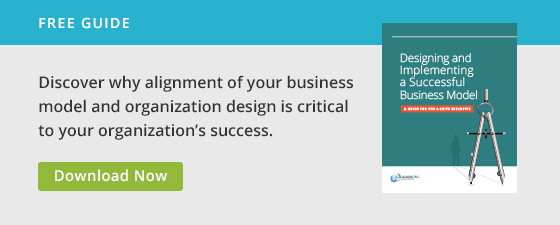Organization design: What does it mean? Why does your organization need it? How do you find the one that will support your goals?
The selection of the right organization design is a real challenge for today’s leaders – but an important one to tackle. Take the process for granted and you’ll ultimately hurt your organization rather than help it.
Organization Design: What is it and Why is it Necessary?
All organizations need a plan to create value for their customers. That’s why organizations spend time on strategy and on creating a distinctive business model. But strategy and a business model are just the start – they need to be followed by an aligned organization design.
Your strategic business model outlines what you’ll offer your customers and how you will differentiate your offerings. Organization design provides the blueprint for how you will fulfill those objectives—using your unique organizational capabilities and an aligned set of organizational choices. The design you select sets up your organization to meet the demands of the marketplace, while allowing you to differentiate and achieve business returns.
Your organization design will help you answer some difficult questions including:
- What organization choices will ensure that your operations run smoothly and meet your strategic goals?
- How can you maintain enough agility to remain relevant and productive as the marketplace changes?
- What will allow you to focus limited resources on the activities that matter most to customers?
- How you will communicate your differentiated message both internally and externally?
As you’d expect, there are myriad ways to answer each question. Consequently, there is no catchall design that works best for all businesses. That is why executives, business managers, human resource leaders and any professional committed to performance need to be thoughtful when choosing and implementing a design that addresses their organization’s unique circumstances. It’s no longer enough to pick an organization design and implement it – true organization design is an exercise in alignment and fine-tuning.
Many businesses undergo an organization design—or re-design—every few years. Too many rush the process or don’t follow through as they should, often because of pressure to focus on sales and revenue. Others simply neglect the important post-implementation change management. Sadly, some never fully implement the organization design at all.
Best Practices are not an Insurance Policy
With a little research, you may uncover what many would consider “best practices” about how to group people and teams (according to functions, products, geographies, or customers, for example). But be warned, such practices aren’t the insurance policy for business success. Conventional best practices are not a substitute for good, fit-for-purpose organization design.
Instead, consider the following when selecting an organization design for your company:
- Differentiation. How do you want to differentiate your offerings in the marketplace? It is an important question. An organization design that addresses this issue can protect your company against imitation.
- Capabilities. What are your capabilities? What resources can you leverage to meet strategic goals within a reasonable timeframe? Today’s marketplace requires both agility and timeliness. Your organization design should answer these questions.
- Choices. Do you have the right organizational choices in place and are they aligned throughout the organization? You can design all you’d like but without aligning all of the moving parts (e.g., work processes, structure and roles, metrics and information, people and rewards), your organization won’t be able to sustain itself for long. Think of your organization as a Rubik’s cube. The puzzle isn’t solved with only one or two sides in alignment. You need all six sides.
- Trade-offs. Should you include best practices? Basing your organization design solely on what works for someone else rarely succeeds. It becomes a case of racing to the mean. Temper your best practices use. Employ only those that enable efficiency in non-strategic areas of your business.
These considerations are a good start in determining the right organization design for your business. But, as mentioned earlier, finding the right design is just the start. Without a thoughtful plan for implementing it and ensuring achievement by measuring impact, you won’t know if you really chose the right design.
Parting Thoughts
The ultimate goal—and one of the greatest challenges for executives—is to implement an organization design that effectively supports your business model. What’s more, recognize that it’s not a “one and done” proposition. Even the best organization design may require tweaking to ensure full alignment with your business model as marketplace conditions change.
If – after implementation and follow up – you discover that your organization brings value to your customers, allows for flexibility in adjusting to changing conditions, gives you a competitive edge AND results in a profitable bottom line, then you will know that you have designed an effective organization.

